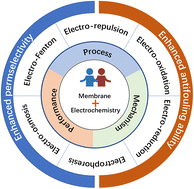Carbon nanomaterial-based membranes for water and wastewater treatment under electrochemical assistance
Abstract
Membrane separation has been widely used in water and wastewater treatment due to its relatively low cost, easy operation and high efficiency. However, current membranes suffer from a trade-off between selectivity and permeability as well as membrane fouling. Recently, numerous studies have focused on the development of carbon nanomaterial (typically, carbon nanotube and graphene)-based membranes with high performance for water and wastewater treatment. Many studies have demonstrated that benefiting from the good electrical conductivity of carbon nanomaterial-based membranes, their permselectivity and fouling resistance can be further improved under electrochemical assistance. Herein, we review the recent progress in the preparation, mechanisms and applications of electroconductive nanocarbonaceous membranes for water purification and wastewater treatment, aiming at improving the fundamental understanding of the combination of membrane separation and electrochemistry. Firstly, we summarize the recent methods for the preparation of some typical electroconductive membranes, for example, carbon nanotube membranes and graphene membranes. Subsequently, we discuss the underlying mechanisms (e.g., electro-oxidation, electro-adsorption, and electrostatic interactions) for the electrochemically enhanced permselectivity, antifouling and regeneration performance, and finally highlight the practical limitations of membrane/electrochemistry systems and outline possible solutions.

- This article is part of the themed collections: Environmental Science: Nano Recent Review Articles and Nanomaterial applications in water


 Please wait while we load your content...
Please wait while we load your content...